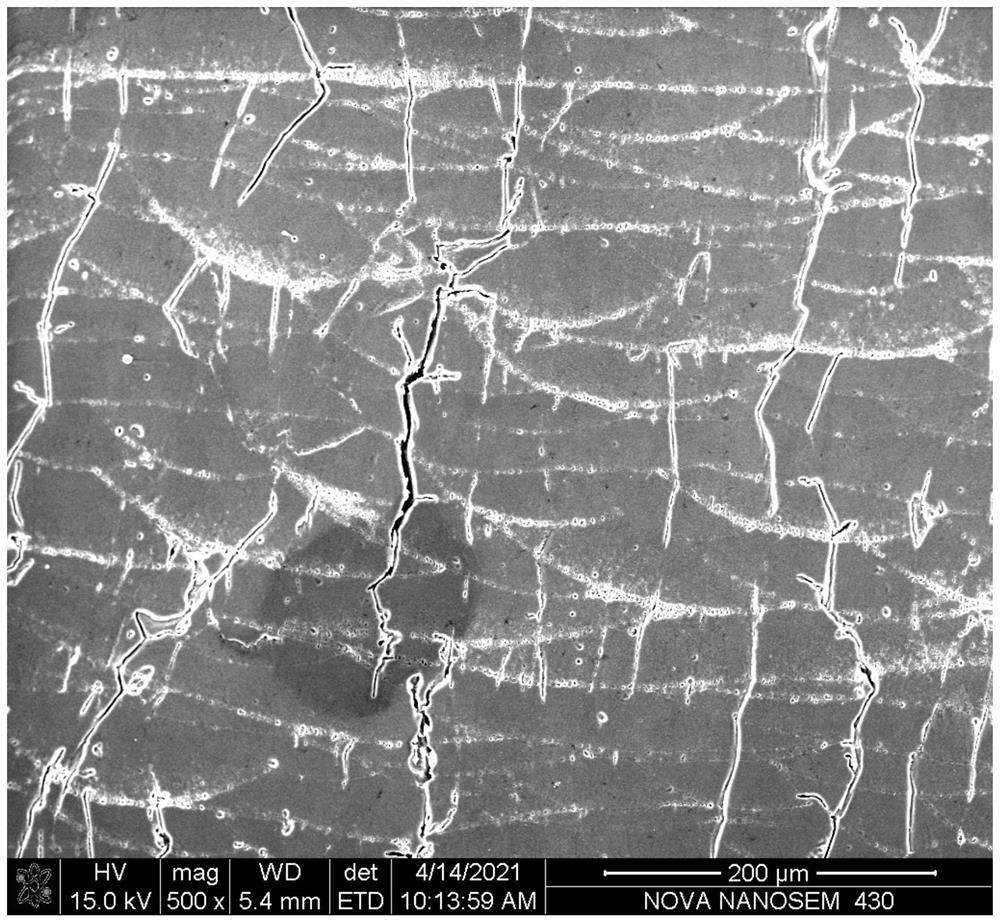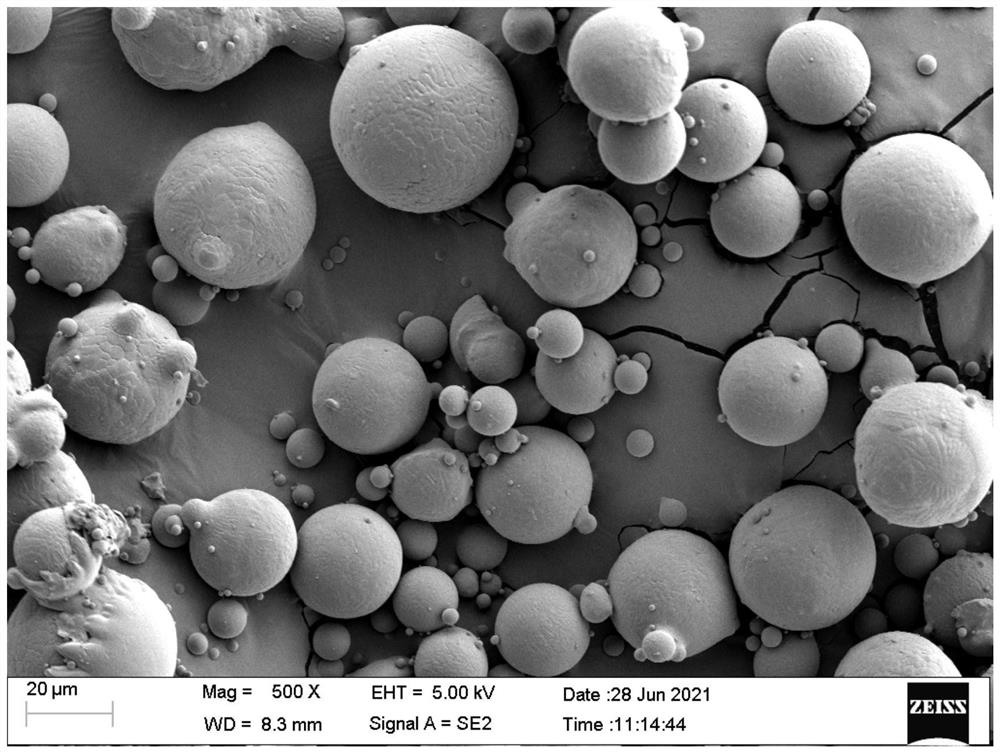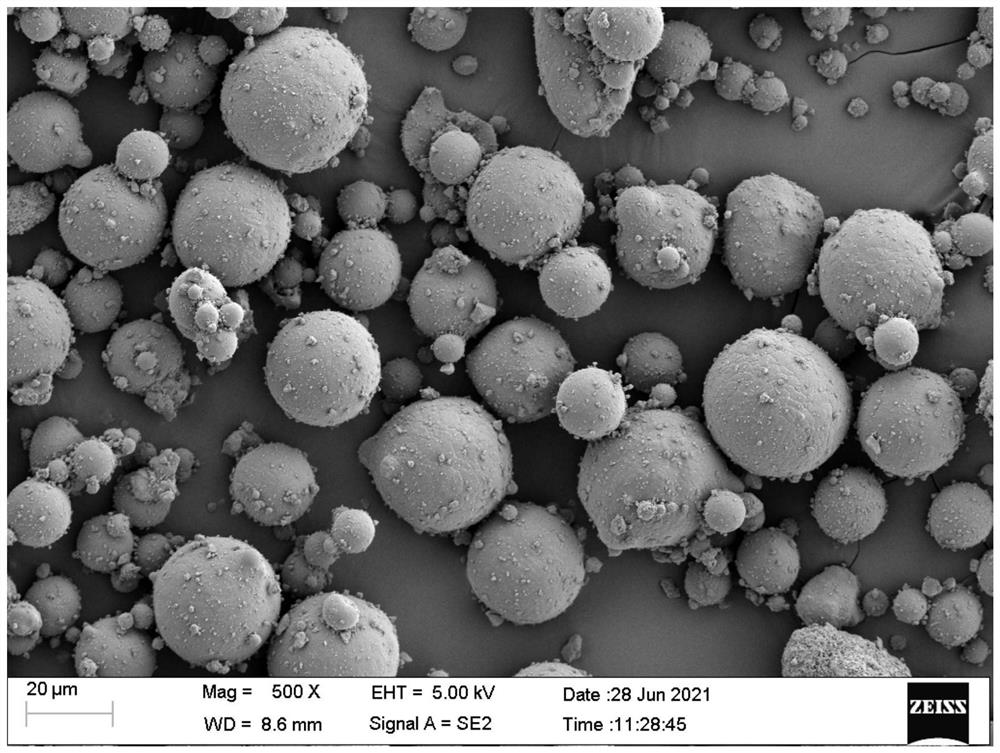Double-phase submicron particle modified aluminum-based composite powder for 3D printing and preparation method of double-phase submicron particle modified aluminum-based composite powder
A dual-phase submicron, 3D printing technology, applied in additive manufacturing, metal processing equipment, process efficiency improvement, etc., can solve the problems of easy oxidation and high preparation cost, achieve good powder sphericity, reduce preparation cost, laser The effect of increasing the absorption rate
- Summary
- Abstract
- Description
- Claims
- Application Information
AI Technical Summary
Problems solved by technology
Method used
Image
Examples
Embodiment 1
[0040] Step 1: Weigh 95.5g of 6061 aluminum alloy powder and 0.5g of TiH in a vacuum glove box 2 For ceramic particles, put the mixed powder into a ball mill jar and add stainless steel balls. The ball-to-material ratio during the ball milling process is 5:1.
[0041] Step 2: Fill the ball mill jar with argon as a protective gas.
[0042] The third step: carry out intermittent ball milling. The ball milling speed was 125 r / min, and the ball milling time was 3 h, and the aluminum matrix composite powder was finally obtained.
[0043] Step 4: Take out the composite powder in the vacuum ball mill tank in the vacuum glove box, and carry out vacuum packaging.
[0044] After the above steps, submicron TiH can be prepared 2 Composite powder with a mass fraction of 0.5 %, TiH prepared by SLM process 2 After / 6061 composite powder, such as Figure 5 The number of thermal cracks in the SLM formed sample shown is relatively small but still exists. The tensile strength reaches 120MPa...
Embodiment 2
[0046] Step 1: Weigh 99g of 6061 aluminum alloy powder and 1g of TiH in a vacuum glove box 2 For ceramic particles, put the mixed powder into a ball mill jar and add stainless steel balls. The ball-to-material ratio during the ball milling process is 5:1.
[0047] The second step: fill the ball mill jar with argon.
[0048] The third step: carry out intermittent ball milling. The ball milling speed was 130r / min, and the ball milling time was 4 h, and the aluminum matrix composite powder was finally obtained.
[0049] Step 4: Take out the composite powder in the vacuum ball mill tank in the vacuum glove box, and carry out vacuum packaging.
[0050] After the above steps, submicron TiH can be prepared 2 Composite powder with a mass fraction of 1%, TiH prepared by SLM process 2 After the / 6061 composite powder, the cracks in the SLM formed sample have been completely eliminated, and the tensile strength has reached 270MPa and the elongation has reached 18% as measured by the ...
Embodiment 3
[0052] Step 1: Weigh 98g of 6061 aluminum alloy powder and 1g of TiH in a vacuum glove box 2 Ceramic particles and 1g of Mg 2 Si ceramic particles, put the mixed powder in the ball mill jar, and add stainless steel balls, the ball-to-material ratio during the ball milling process is 5:1.
[0053] The second step: fill the ball mill jar with argon.
[0054] The third step: carry out intermittent ball milling. The ball milling speed was 130 r / min, the ball milling time was 5 h, and the aluminum matrix composite powder was finally obtained.
[0055] Step 4: Take out the composite powder in the vacuum ball mill tank in the vacuum glove box, and carry out vacuum packaging.
[0056] After the above steps, submicron TiH can be prepared 2 Mass fraction is 1%, submicron Mg 2 The mass fraction of Si is 1%, and the two are uniformly dispersed on the composite powder of AA6061 matrix powder. Formed by SLM process (TiH 2 +Mg 2 Si) / 6061 composite powder, its tensile strength reaches...
PUM
| Property | Measurement | Unit |
|---|---|---|
| particle size | aaaaa | aaaaa |
| particle size | aaaaa | aaaaa |
| tensile strength | aaaaa | aaaaa |
Abstract
Description
Claims
Application Information
 Login to View More
Login to View More - R&D Engineer
- R&D Manager
- IP Professional
- Industry Leading Data Capabilities
- Powerful AI technology
- Patent DNA Extraction
Browse by: Latest US Patents, China's latest patents, Technical Efficacy Thesaurus, Application Domain, Technology Topic, Popular Technical Reports.
© 2024 PatSnap. All rights reserved.Legal|Privacy policy|Modern Slavery Act Transparency Statement|Sitemap|About US| Contact US: help@patsnap.com










